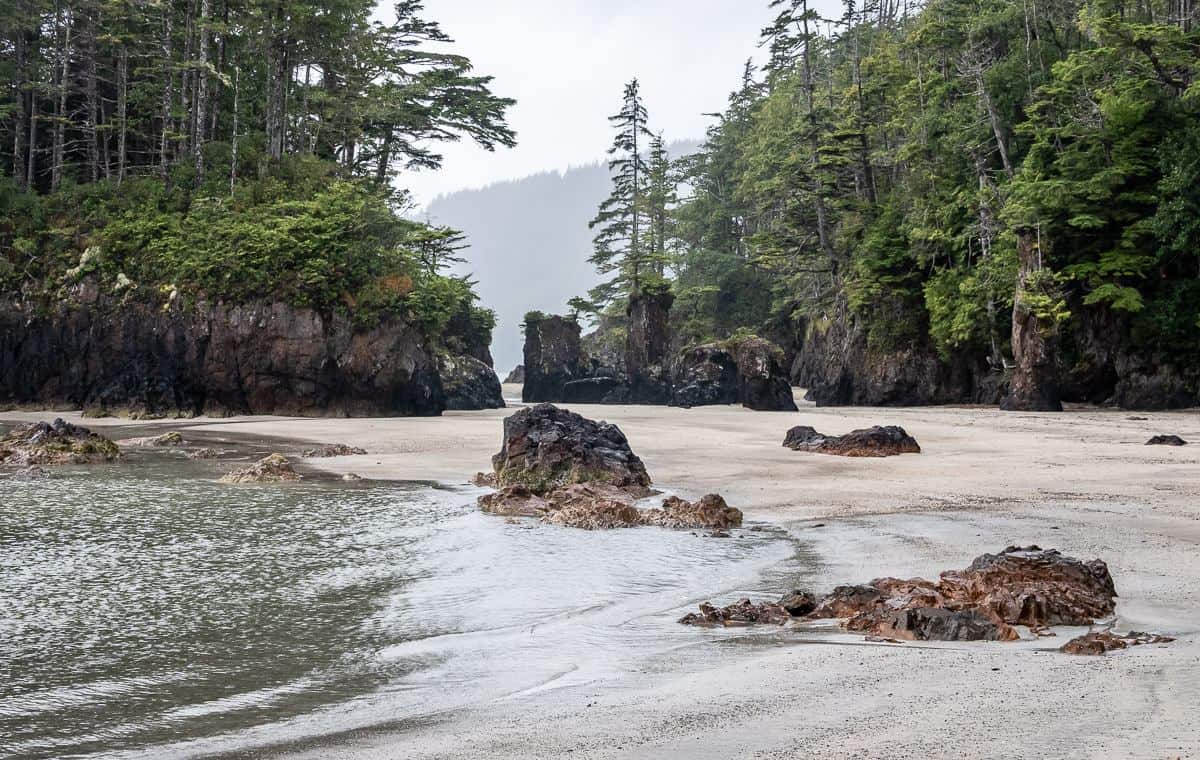
The San Josef Bay hike is as easy as they come. Both day hikers and overnight campers will enjoy a flat walk on a wide gravel trail through temperate rainforest near the northern tip of Vancouver Island. You can even push a stroller or pull a wagon with your gear! There are no route-finding issues as the one intersection is well-signed.
Along the San Josef Bay hike a couple of massive trees including a western cedar and Sitka spruce will stop you dead in your tracks. Once at the beach, assuming you’re visiting on a falling tide, explore tide pools, walk among the stunning sea stacks, and poke your nose in a couple of small caves.
Keen hikers can test their mettle on a 6 km return hike from the western end of Second Beach up to the summit of Mount St. Patrick, topping out at 416 m or 1,365 feet. The trail offers technical terrain, plenty of mud and a unique upland bog. From the summit you can reportedly see the wind turbines of the Cape Scott Wind Turbine Farm, Sea Otter Cove and the Helen Islands.
Even though the drive to the trailhead can be a gnarly one, the San Josef Bay area is popular -mainly because the hike is so easy, and the area is beautiful. It’s also a great place to camp, particularly for families with young children.
I’m happy I experienced it, though my personal preference will always be the wild white sand beaches that few people visit along the North Coast Trail and Cape Scott Trail.

 Beautiful big trees on the San Josef Bay trail
Beautiful big trees on the San Josef Bay trail
San Josef Bay hike summary
Distance: 5.0 km return.
Level of difficulty: Easy and family friendly.
Time needed: 45 minutes each way to the parking lot.
When to visit: Cape Scott Provincial Park is open year-round but you’ll find the best weather windows and warmer temperatures in the summer.
Know before you go: Visit Destination BC’s Know Before You Go page. With conditions changing rapidly, it also pays to check out Drive BC, BC Wildfire Service, and Emergency Info BC. It would be a good idea to download and allow notifications from Alertable, an app which delivers geographically relevant updates.
Campgrounds: See below. First come, first served. Avoid on summer long weekends as they get very busy.
Dogs allowed: Yes, on a leash but best left at home because of wildlife.
Wildlife: Black bears and wolves might be seen on the San Josef Bay hike. Carry easy to access bear spray. Know what to do if you meet a bear or a wolf.
Don’t forget: Pack the 10 hiking essentials – even for this short hike.
Trash: San Josef Bay is heavily used because it’s so easy to access. Unfortunately, many visitors are leaving heaps of trash in the bear-proof containers and along the beach. We saw it for ourselves when we met a ranger wheeling a giant bag of trash to the parking lot. Please!!! practice the Leave No Trace principles. We all want to visit a clean beach and enjoy garbage-free campgrounds and washrooms.
Hiking Tours: Check out Cove Adventure Tours. Their price includes transportation from Port Hardy to the trailhead.
Tide charts: Check the Cape Scott tide charts to time your visit with a falling tide.
Swimming: Beware of rip currents. See photo below.
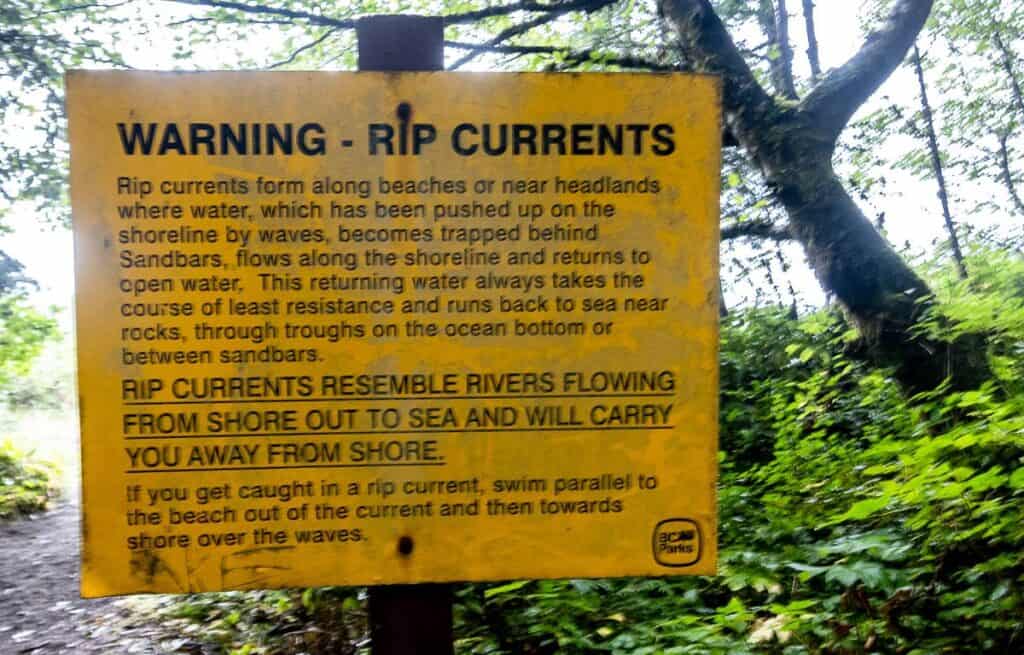
 Rip currents are an issue at San Josef Bay
Rip currents are an issue at San Josef Bay
Getting to the San Josef Bay trailhead
There are two ways to get to the San Josef Bay trailhead – drive or take a van shuttle from Port Hardy with Cape Scott Water Taxi. Most people elect to drive but be warned that the active logging road to Cape Scott Provincial Park can be a rough and muddy one. It is not a road for an RV, campervan or rental vehicle.
If you’re driving up from Campbell River, head towards Port Hardy on Highway 19, approximately 225 km to the north. Allow around 2.5 hours to reach the turnoff. There aren’t a lot of passing lanes and it’s easy to get stuck behind slow moving vehicles. Be patient.
Just before you get to Port Hardy, turn left onto Holberg Road – a logging road that is accessible to 2WD cars – but go easy and watch for logging trucks. ALWAYS yield to a logging truck – as they have the right of way, and they are way bigger than you are.
From the turnoff to Port Hardy, it’s 46.6 km to reach the community of Holberg, a logging camp and former Canadian Forces Station base. It will take you about an hour to get here. If you’ve forgotten fuel or food, visit the Holberg Pitstop. It’s also got an onsite liquor store.
Continue through Holberg and pick up the San Josef Main Forest Service Road. Look for signage directing you to Cape Scott Provincial Park – a further 19 km away. There is a large gravel parking lot and a well-signed trailhead for the San Josef Bay hike near the shelter. Allow at least two hours to get here from Port Hardy.
Tip: Fill up your vehicle before you go. This road is no place to run out of gas.
San Josef Bay hike description
Pick up the San Josef Bay hike at the northwest corner of the parking lot. You’ll be walking in a temperate rainforest filled with shades of green. Look for a big old-growth cedar on the right-hand side of the trail as you walk.
At 1.0 km reach a signed junction. Go left to stay on the San Josef Bay hike. Again, look for some big old-growth trees in the area including a massive red cedar. Just before you cross a well-built bridge, check out the interpretive sign describing Henry Olsen’s store and post office.
After crossing the bridge keep an eye out for a very cool set of intertwined roots from three trees, the result of a nurse log. It is quite a sight! After one more bridge crossing, you’re within spitting distance of San Josef Bay. Enjoy the beach and the sea stacks.
If you go left, you can explore the San Josef Estuary but it was rainy when we were there, so we gave it a pass. To camp head right and start looking for unoccupied campsites – preferably with trees so you can set up a tarp.
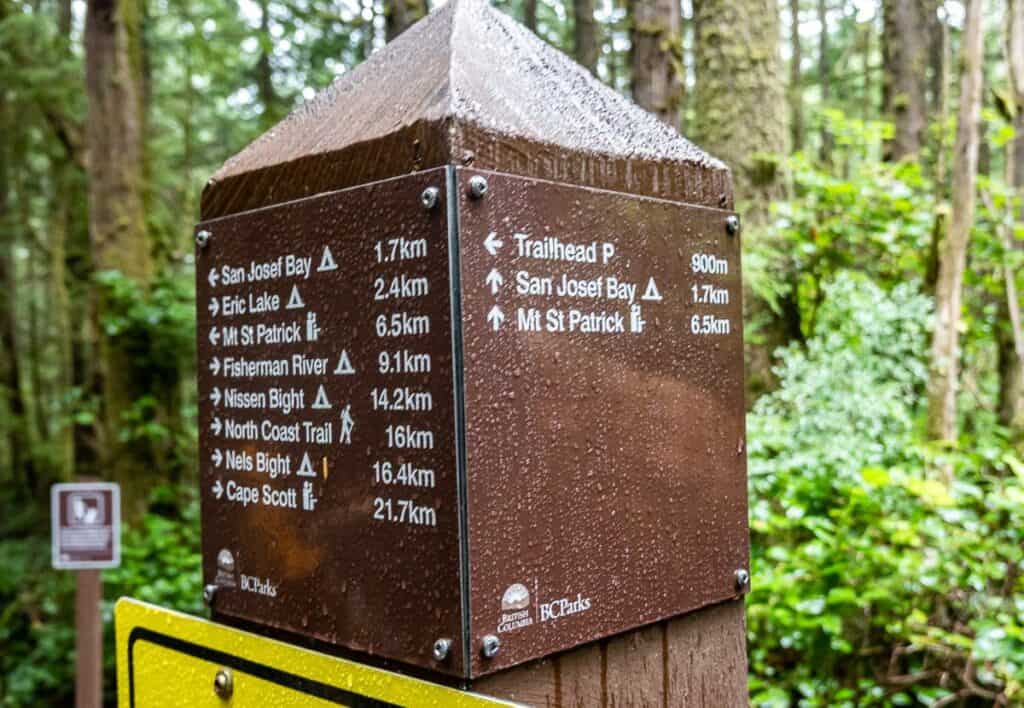
 Excellent signage on the San Josef Bay hike
Excellent signage on the San Josef Bay hike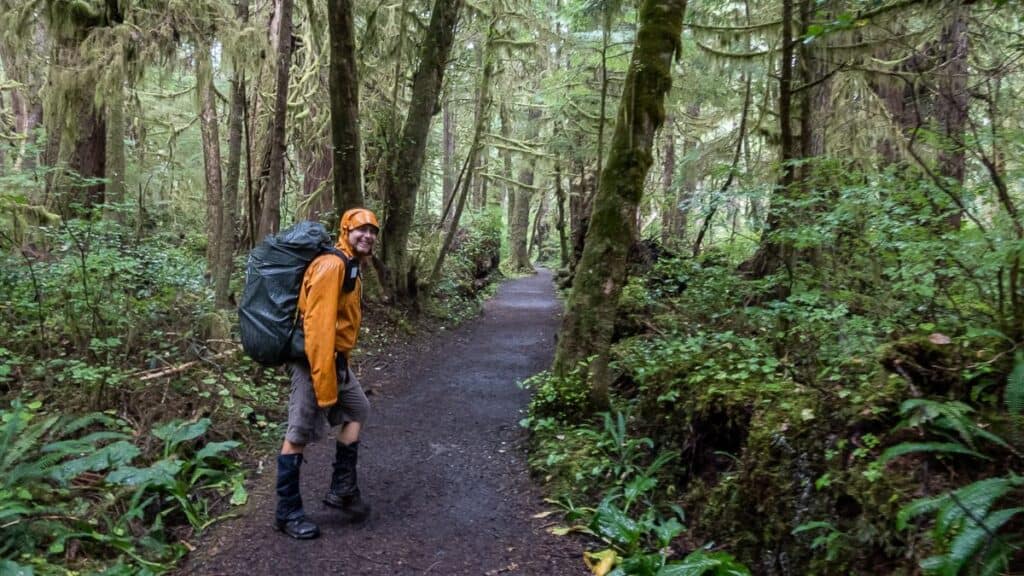
 After the North Coast Trail, the San Josef Bay hike felt like a “walk in the park”
After the North Coast Trail, the San Josef Bay hike felt like a “walk in the park”
 Interpretive sign near the site of Henry Olsen’s store
Interpretive sign near the site of Henry Olsen’s store
 One of the massive old-growth cedar trees seen along the San Josef Bay hike
One of the massive old-growth cedar trees seen along the San Josef Bay hike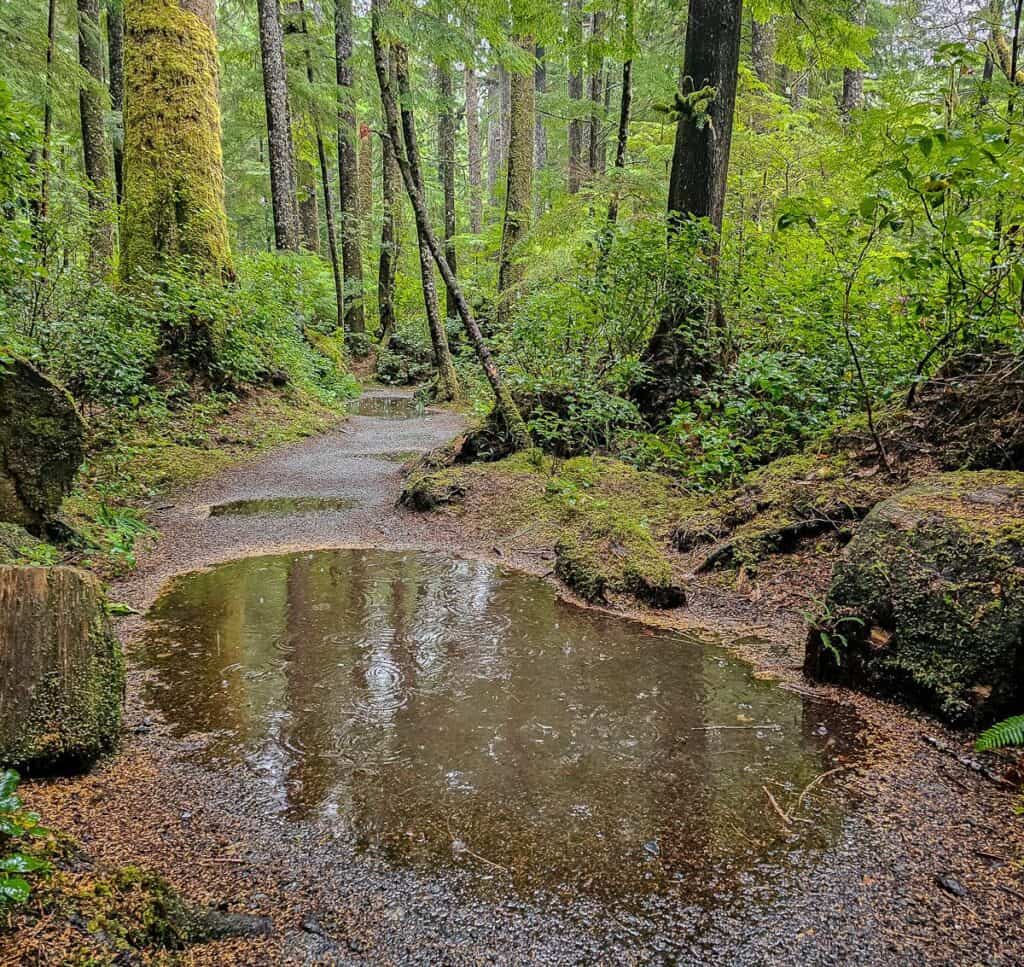
 It’s hard to stay dry with big puddles like this
It’s hard to stay dry with big puddles like this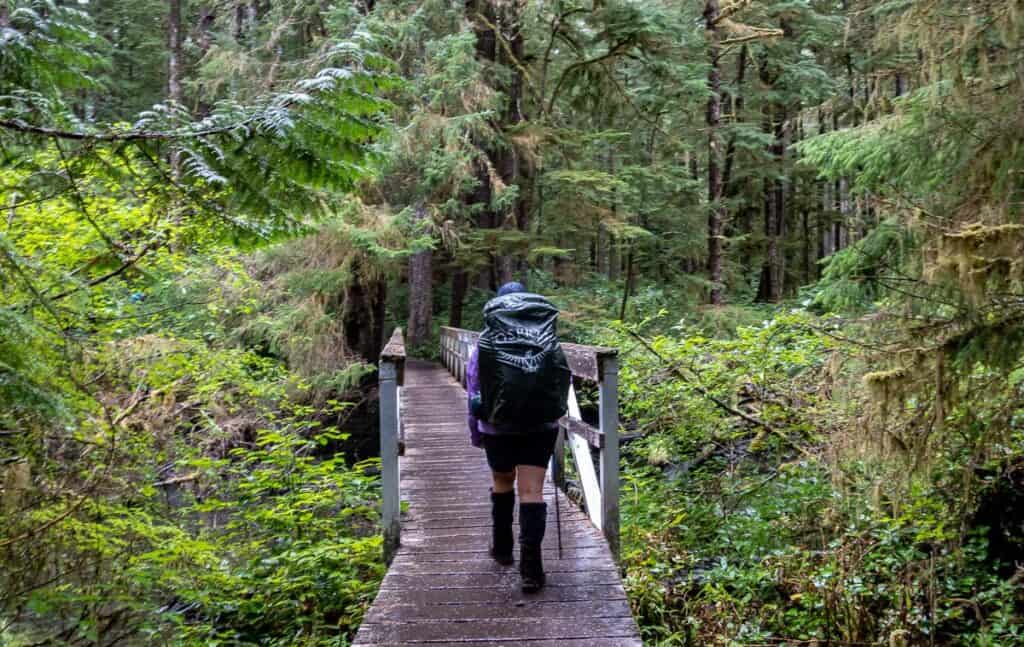
 One of the sturdy bridges you cross on the hike to San Josef Bay
One of the sturdy bridges you cross on the hike to San Josef Bay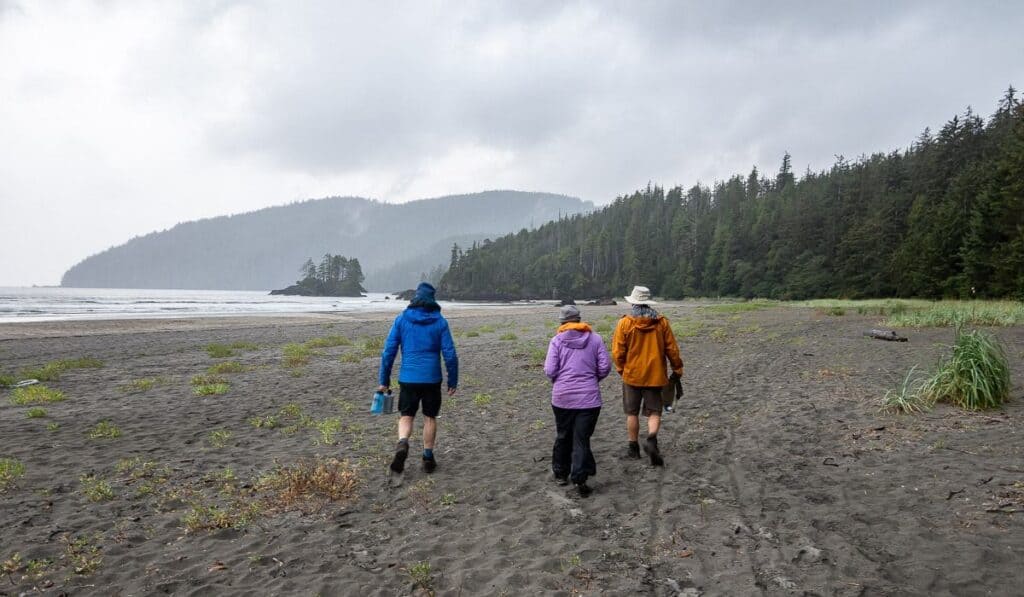
 Exploring the beach at San Josef Bay
Exploring the beach at San Josef Bay
Camping at San Josef Bay in Cape Scott Provincial Park
Reservations: None needed, but you do need a BC Park permit (click on Backcountry and then Backcountry Registration) between May 1 and September 30. The price is $10 per adult and $5 per child per night.
Campgrounds: There are two campgrounds – First Beach and Second Beach Campgrounds. First Beach is easy to reach as it’s at the end of the trail. Second Beach can be a challenge – and it’s the only one with a water source.
First beach Campground
Campsites: They are numerous campsites tucked into the trees along the length of the beach. If it’s windy or rainy, the best sites are down the beach closest to the sea stacks. Don’t forget atarp or twoand rope.
Food storage: There are at least four sets of bear-proof lockers. Don’t leave anything behind.
Water: None. Bring what you need, or you’ll have to go to Second Beach Campsite which isn’t easy to access if it’s high tide. Any river or water body you see between the parking lot and the campground has brackish water only.
Toilets: Look for at least three outhouses – all with toilet paper back in the woods.
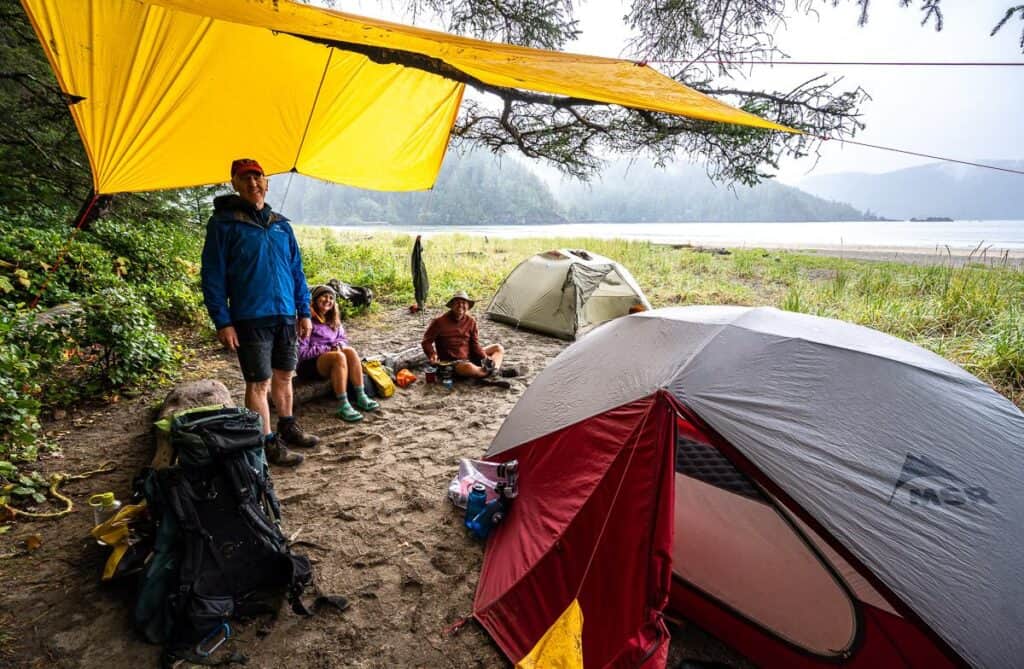
 Our campsite on San Josef Bay on a rainy night
Our campsite on San Josef Bay on a rainy night
Second Beach Campground
There are two ways to reach Second Beach Campground depending on the tide. If the tide is below 1.7 m (5.6 feet) you can walk to the beach by heading towards the sea stacks and continuing around a headland – where the beach will then be visible. If you can possibly time your arrival with low tide, this is definitely the way to go.
Otherwise, you have a short but tough hike up and over a bypass trail that’s reminiscent of the North Coast Trail. The trail is behind the first islet in a gully. It’s steep and you will need to use the ropes in place though the high point is just 40 m or 131 feet above sea level.
Continue through thick vegetation and mud and then descend to a beach at the back of a surge channel. Continue along the coast to the right past more rocks to reach the campground. Look for sites above the high tide line amongst the driftwood.
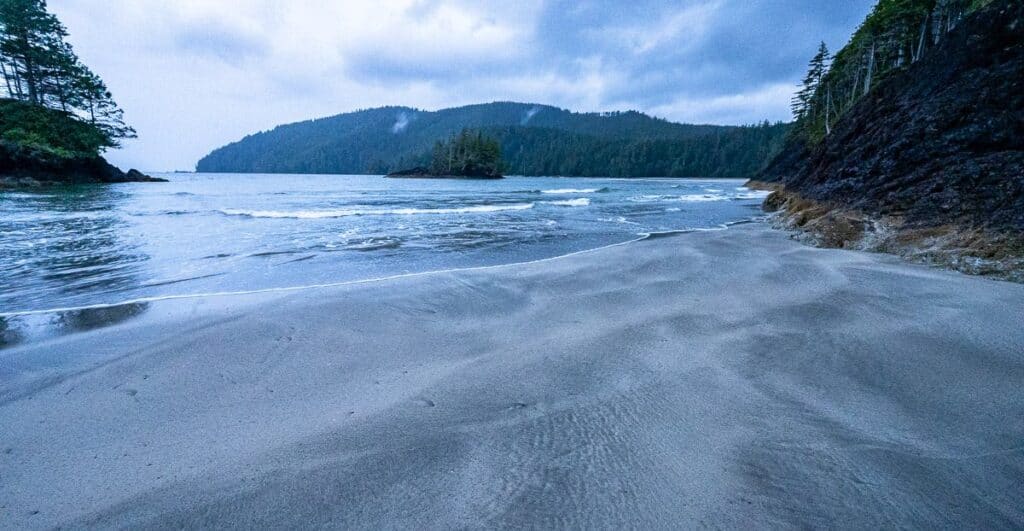
 The Second Beach Campground on San Josef Bay is around the headland on the right and can only be reached at low tide unless you hike the somewhat nasty overland route
The Second Beach Campground on San Josef Bay is around the headland on the right and can only be reached at low tide unless you hike the somewhat nasty overland route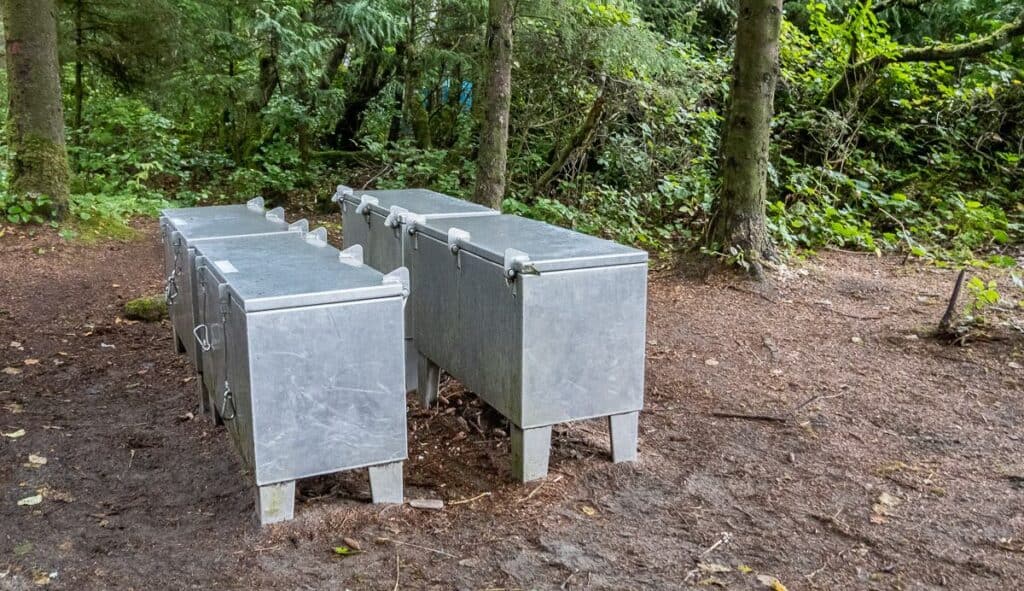
 The bear-proof lockers look like this at San Josef Bay
The bear-proof lockers look like this at San Josef Bay
Photos of the sea stacks at San Josef Bay
We didn’t start exploring the sea stacks until after dinner – and by then it was raining softly and the light was starting to fade. Still, it’s a beautiful area and you could easily spend an hour or two walking around, especially if you love photography.
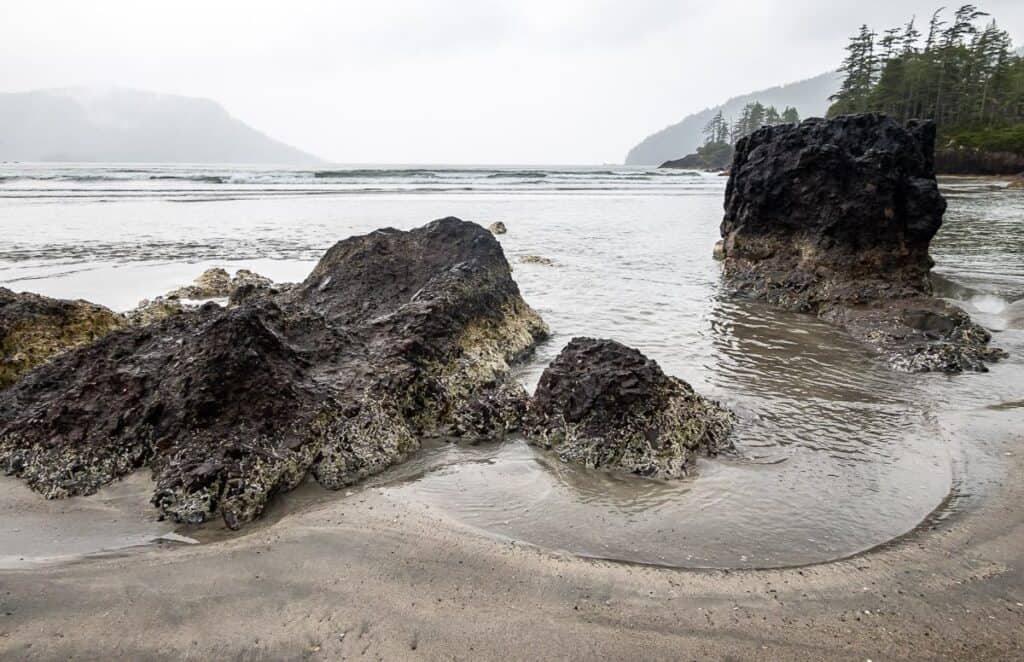
 Interesting rocks at San Josef Bay
Interesting rocks at San Josef Bay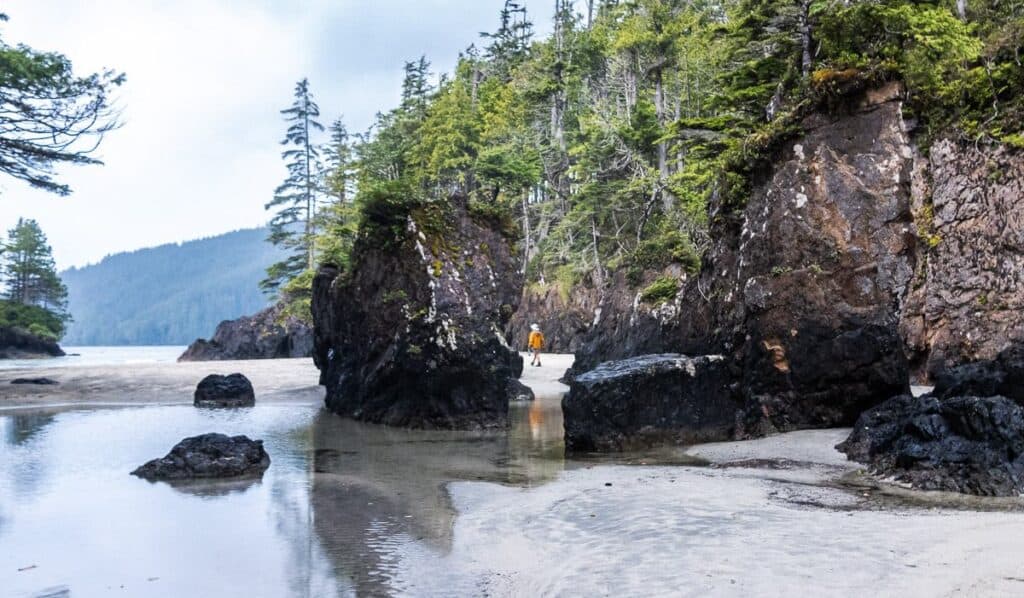
 Wonderful walking among the sea stacks
Wonderful walking among the sea stacks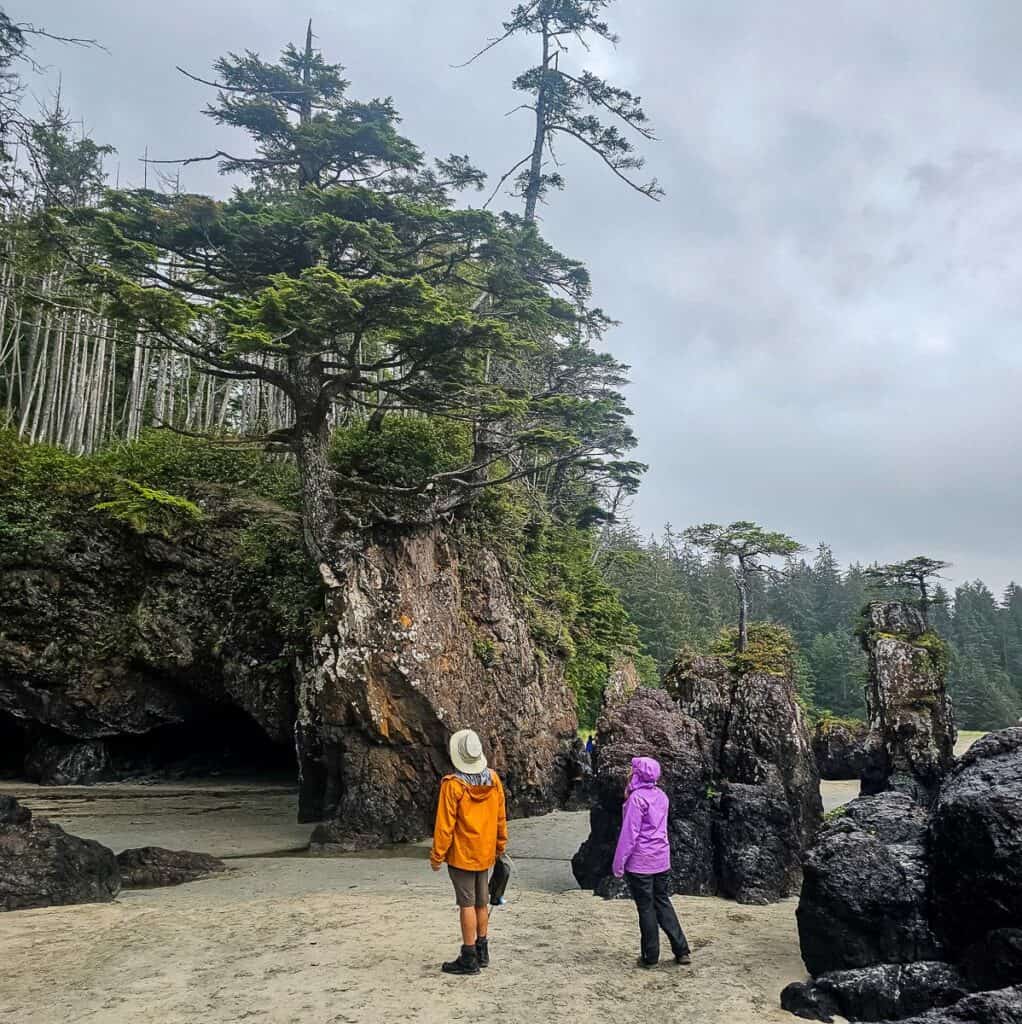
 A stunning sea stack-filled landscape at San Josef Bay
A stunning sea stack-filled landscape at San Josef Bay
 My friend Gemma admiring the caves at San Josef Bay
My friend Gemma admiring the caves at San Josef Bay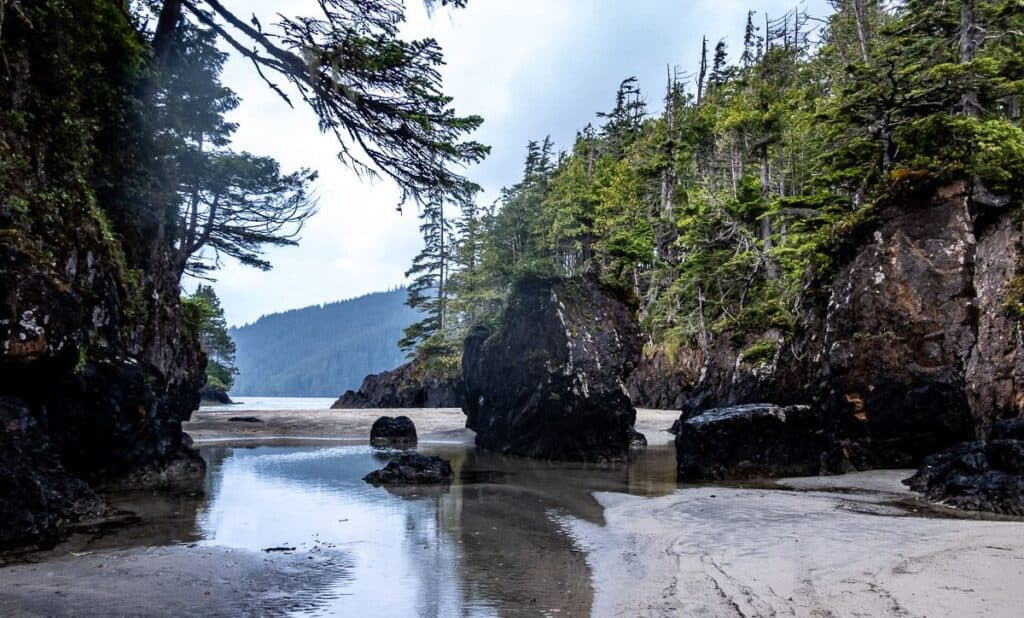
 The area around the sea stacks at San Josef Bay is mesmerizing
The area around the sea stacks at San Josef Bay is mesmerizing 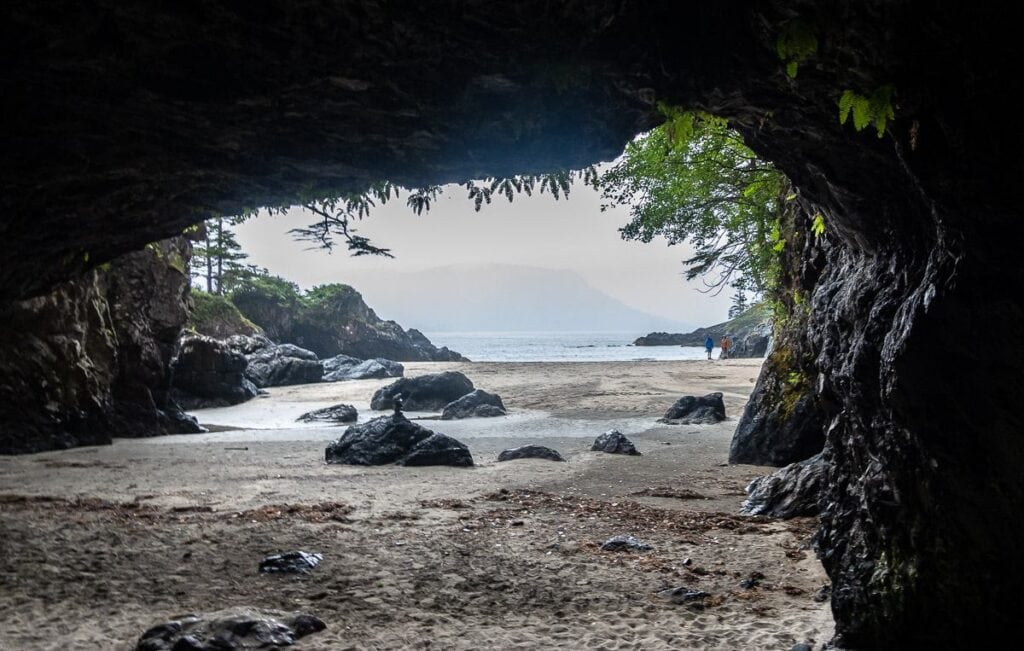
 Looking out from inside the cave
Looking out from inside the cave
On the drive out
If you’re looking for a hot meal and even a warm bed after your San Josef Bay hike, check out the Scarlet Ibis Pub in Holberg. They bill themselves as the most remote pub on Vancouver Island.
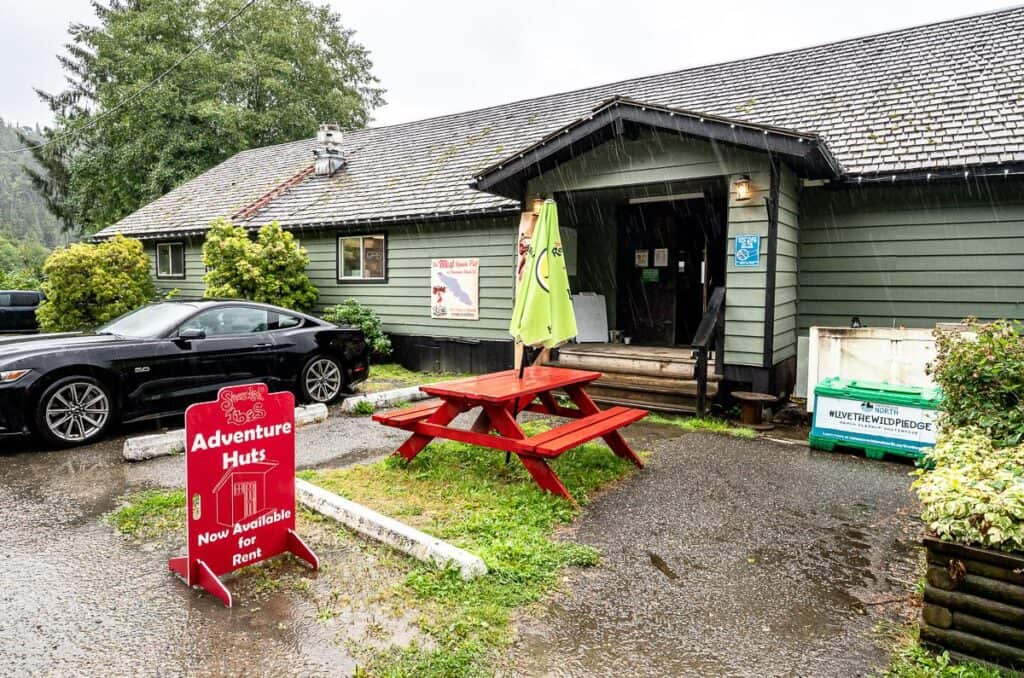
 After your hike or camp, enjoy a hot meal in Holberg at the Scarlet Ibis
After your hike or camp, enjoy a hot meal in Holberg at the Scarlet Ibis
Where to stay in Port Hardy before or after the San Josef Bay hike
For a B&B: Check out the exceptionally ratedTelco House B&B.
For cabins: Visit –Port Hardy Cabins– rated superb. I also very much like Ecoscape Cabins, just a few minute’s drive from Port Hardy.
Hostel: TheNorth Coast Trail Backpackers Hostelis rated as very good.
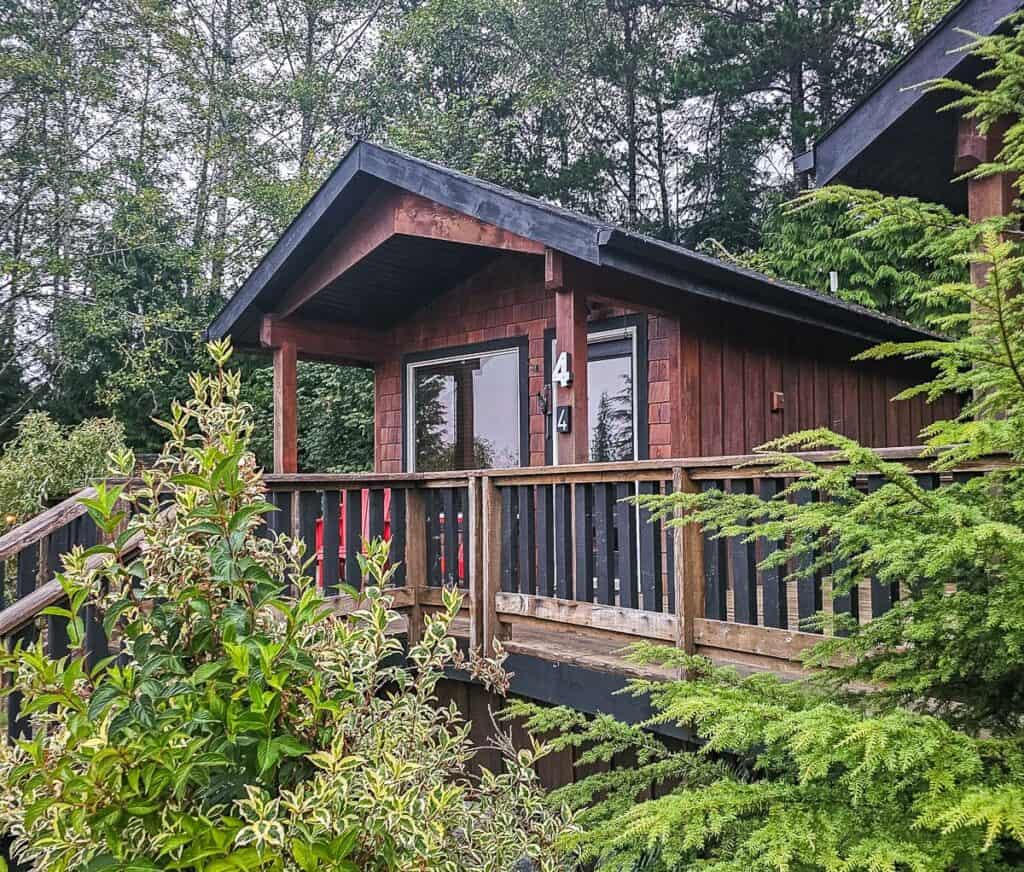
 Our Ecoscape cabin in Port Hardy
Our Ecoscape cabin in Port Hardy
Further reading on Vancouver Island hikes and backpacking trips
Click on the photo to bookmark to your Pinterest boards.
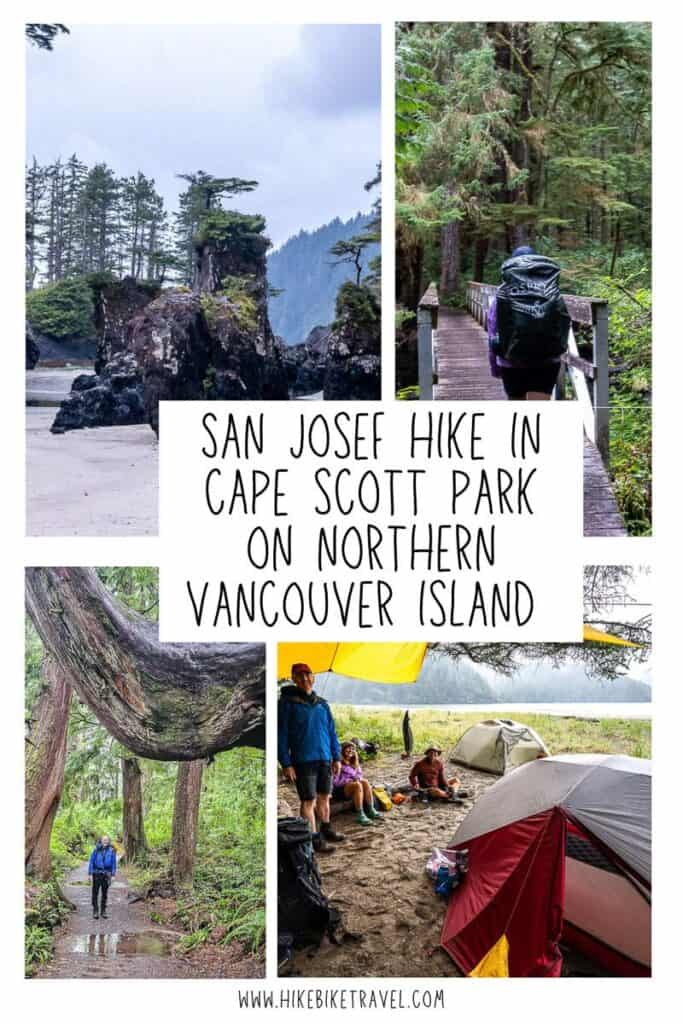

Please visit:
Our Sponsor
